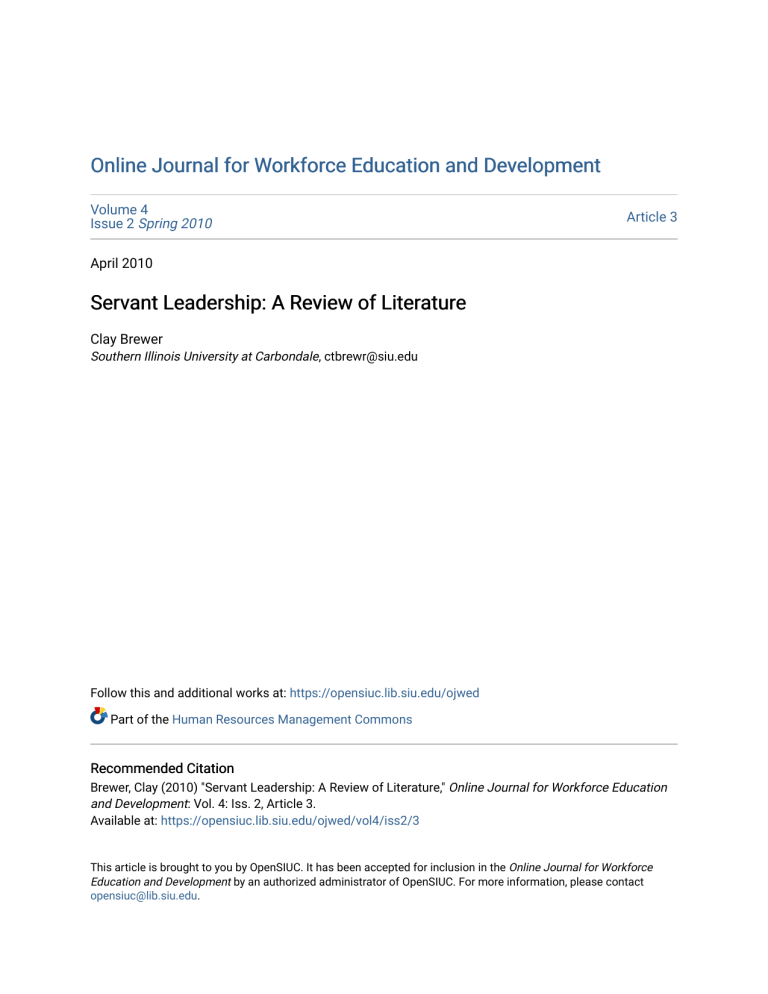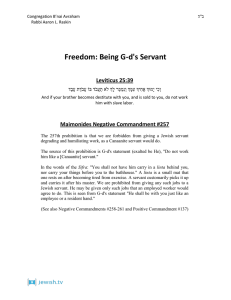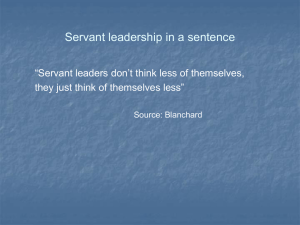
Online Journal for Workforce Education and Development Volume 4 Issue 2 Spring 2010 Article 3 April 2010 Servant Leadership: A Review of Literature Clay Brewer Southern Illinois University at Carbondale, ctbrewr@siu.edu Follow this and additional works at: https://opensiuc.lib.siu.edu/ojwed Part of the Human Resources Management Commons Recommended Citation Brewer, Clay (2010) "Servant Leadership: A Review of Literature," Online Journal for Workforce Education and Development: Vol. 4: Iss. 2, Article 3. Available at: https://opensiuc.lib.siu.edu/ojwed/vol4/iss2/3 This article is brought to you by OpenSIUC. It has been accepted for inclusion in the Online Journal for Workforce Education and Development by an authorized administrator of OpenSIUC. For more information, please contact opensiuc@lib.siu.edu. Online Journal of Workforce Education and Development Volume IV, Issue 2 – Spring 2010 Servant Leadership: A Review of Literature Clay Brewer Southern Illinois University at Carbondale 1 Online Journal of Workforce Education and Development Volume IV, Issue 2 – Spring 2010 Servant Leadership: A Review of Literature Abstract The philosophical foundation of servant leadership existed thousands of years ago. Servant leadership is a unique style of leadership ideology which flows against the grain of self-interest human behavior. America’s financial collapse has created need for leaders to unite with followers and defy the trade and industry meltdown. Servant leadership values reflect and heal the organizational needs necessary in pioneering the road to recovery from the economic recession. In this paper, servant leadership is characterized by listening, empathy, healing, awareness, persuasion, conceptualizing, foresight, stewardship, commitment to growth, and community building (Spears, 2004). The application of servant leadership principles creates increased job satisfaction and improves organizational productivity. Drawing on literature review linking servant leadership to job satisfaction, data exists to conclude organizations which adopt servant leadership doctrines lead to success, significance and perform at higher levels. 2 Online Journal of Workforce Education and Development Volume IV, Issue 2 – Spring 2010 Servant Leadership: The Foundation, Function and Success The economic downturn has delivered many woes, the stock market is depressed, housing has plummeted and mass layoffs have vexed the workforce. America is in desperate need for ethical and effective leadership that serves others, invests in their interests and fulfills shared visions. Economic hardships have placed employees into a state of fear and productive rigor mortis. There has been no greater time for leaders to establish relations and connect with followers. Among the various leadership styles, the approach with the most intimate touch that embodies the human factor is servant leadership (Page & Wong, n.d.). Necessary in thrusting organizations forward will be the ability for employees to trust in their organizations leadership. “Trust is the foundation of leadership” (Maxwell, 1998, p. 65). The bottom line is followers careless about how much a leader knows until they know how much a leader cares. Ken Blanchard, who put Leadership Training on the map, defines servant leaders as “humble people who don’t think less of themselves, they just think about themselves less. They don’t deny their power; they just realize it passes through them, not from them (Blanchard, 2007, p. 263). A fundamental principle supporting servant leadership is to gain in-depth knowledge of followers. Effective leaders recognize it takes sincere effort and compassion to reach someone’s heart and you must touch their heart before you ask them for a hand (Maxwell, 1998). Leaders must win people over before they enlist their support. Fostering cooperation through deepening relations between leaders and followers is a positive stride towards ascending out of economic abyss. History of Servant Leadership Of the various leadership styles, no other leadership style has a deeper or stronger historical base than servant leadership. The concept of servant leadership can be traced through passages dating back to the 4th century B.C., most notably passages documented from Lao-Tzu who lived in China 570 B.C. Lao-Tzu was a Chinese philosopher who was deeply influential, his teachings of servant hood were aligned with rescuing society from moral decay (Servant Leadership, 2010). An additional historical example of servant hood is Jesus teachings to his disciples in the New Testament Book of Mark; He instructed his disciples that “whoever wishes to be ruler over others must first be servants themselves” (Mark New International Version).The book of John is a wonderful example of the ultimate Leader being a servant first. After an exhausting day of roving dusty roads by foot and preaching the Gospel, Jesus himself, removed the sandals from his disciples then washed their feet before cleansing his own (John New International Version). Four decades ago, the tumultuous sixties birthed the concept of servant leadership and brought this unique leadership style to the forefront. The forefather of servant leadership was a popular essayist and management researcher, Robert Greanleaf. Greanleaf was perplexed by the Cultural Revolution and became inquisitive to why the youth of America were so defiant. His in-depth research concluded the nucleus of the mutinous movement derived from America’s Institutions inability to adequately serve others. In early 1970, Robert Greanleaf wrote an essay targeting poor leadership as the impetus for the uprising of the sixties. His composition promoted old theories as a new application to leadership; he expanded on the idea of service to others and coined the phrase servant leadership. His writings became influential and attracted interests of corporate executives. Greanleaf (1991), an AT&T executive, implemented servant leadership principles to ensure his employee’s highest-priority needs were being served. The results of his innovative engagement strategies were astonishing. He continued to publish several more essays measuring his theory against despots and cynics. Actively immersed in leadership research, Greanleaf (1991) examined the authority of hierarchy structures controlling organizations. His findings were the driving force to write two more essays targeting power within power structures, executive leadership and board of trustees (Greenleaf, 1991). 3 Online Journal of Workforce Education and Development Volume IV, Issue 2 – Spring 2010 Foundation of Servant Leadership Evangelist Billy Graham states, “Tears shed for self are tears of weakness, but tears shed for others are a sign of strength” (Myra & Shelley, 2005, p. 237). Many Christians choose to be service oriented leaders versus self-governing dictators. This is attributed to spiritual character. The deep character growth process for Christians involves putting God first in every area of life. The fundamental concept of servant leadership is placing others before self; this is a natural process and characteristic of a Christian. Servant Leaders care about the people that work for them, other person’s agendas come before their own and commitment to service comes first. Considering today’s narcissistic society, the notion of placing ego’s aside and serving others before addressing self interest defies logic. Servant leaders are active pursuers of meaningful professional growth. Devoted servant leadership begins with a conscious effort to establish intimate relationships with the organizations followers. Intimacy has to do with understanding, with believing, and with practice. It has to do with the relationship of one’s work (DePree, 1989). Supervisors who understand people develop insight, a cornerstone in constructing training programs which serve needs and achieve success. Failure is inevitable when people with influence cannot identify weaknesses and promptly adapt. Leaders who only understand policy and procedure can never foster intimacy. Intimacy is the critical component when developing organizational structures and models for achievement. Max Dupree (1989), list three key elements in the art of working together; how to deal with change, how to deal with conflict, and how to reach our potential (p. 59). Methods to successfully face the challenges these elements propose can be linked directly to intimacy of the workforce. Servant leaders understand when employees become aligned with the organizations compass, followers become easier to coach which transcends performance to a higher standard. Intimacy and relationships are the oil that keeps friction down and permits smooth operation within the organization. Servant leaders have a keen understanding of human character and embrace a nurturing teaching style that builds selfesteem. Serving leaders understand institutional objectives are best met when both the needs of the people and the organization are achieved together, and seldom are these two goals equal (DePree, 1992). Successful leaders recognize teamwork always multiplies effectiveness and momentum is a leader’s best friend. Characteristics of Servant-Leaders Robert Greenleaf’s death in 1990, brought Larry Spears, President and C.E.O. of the Greanleaf Center for Servant Leadership, to the forefront of service leadership. Larry Spears expanded upon Greenleaf’s writings and extracted ten common denominators of significant importance characterizing servant leadership. All ten characteristics become entwined within each other when advanced servant leadership initiatives are implemented (Spears, 2004). Listening. Successful people understand the incredible value of becoming a good listener. The ability to listen to others is the foundation to establishing relations with followers. The ability to intently listen to others is a learned trait (Spears, 2004). Woodrow Wilson, the twenty-eighth American president once said “The ear of the leader must ring with the voices of the people (as cited in Maxwell, 2003, p. 41). Leaders should understand listening is meeting a need. If you wish to relate well with your employees you must listen intently and absorb what they can offer. Employees understand a deaf ear equates to a closed mind. Servant leaders understand that listening gains knowledge. Listening is a wonderful benefit, it enables leaders to obtain information and find meaning in what is being said (Spears, 2004). 4 Online Journal of Workforce Education and Development Volume IV, Issue 2 – Spring 2010 Empathy. Servant leaders strive to connect and understand people. Empathy begins with understanding a leader is responsible for managing a group, but comprehending the group is comprised of individuals (Spears, 2004). General Norman Schwarzkopf remarked, “I have seen competent leaders who stood in front of a platoon and all they saw was a platoon. But great leaders stand in front of a platoon and see it as 44 individuals, each of whom has aspirations, each of whom wants to live, each of whom wants to do good” (as cited in Maxwell, 1998, p. 58). Servant leaders personally know each follower and appreciate everyone has something productive to offer (Spears, 2004). Healing. Leaders possess the ability to heal followers. The servant leader is a force of transformation, recognizing the human heart is fragile and life brings many tribulations into the work environment. Servant leaders understand the need to quickly identify hurting individuals and be of assistance in the healing process. Many times hurting people hurt others which can seriously undermine goals and objectives of the organization. There is no greater way to forge relationships with others then by helping individuals overcome life’s obstacles. Achieving wholeness together is a sure way to connect with people. Healing is usually a learning process; astute people grow from the yeast of their failures. Servant leaders understand the same number of people that can be healed is also the same number of people that can be hurt (Spears, 2004). Awareness. Being aware of the organizational climate especially the moral and ethical issues enables leaders to better ascertain conflicts of interests. Establishing values within your organizations strengthens the ability to manage others. Leaders who posses the mental capability of being able to vicariously place themselves in other’s shoes encompass an extraordinary attribute. The ability to clearly vision opposing views is a valuable administrative tool. Servant leadership promotes this very special yet unique human quality (Spears, 2004). Persuasion. Authoritarian leaders make decisions based off position and title, rather than persuasion. Servant leaders build effective group consensus in order to affect change. The ability to convince others to respond as a majority without using coercion is the foundation of teamwork. Leaders who ignore the principles of teamwork restrict the ability to lead and erode individual performance. This trait explicitly signifies the differences between authoritative leaders and servant leaders (Spears, 2004). Conceptualization: Servant leaders think beyond day to day realities and dream great things for the organization. Casting visions is critical to leaders because dreams are the institutions road map to the future. The most successful servant leaders understand far-reaching visions go beyond what the dreamer can accomplish (Spears, 2004). Conceptualization has true value when it not only includes the workforce but adds value to them as well. Many times leaders fail to recognize if the vision doesn’t serve others it’s probably too small (Maxwell, 2003). Foresight. Foresight is the ability to learn from past mistakes and grow from failures (Spears, 2004). Proverbs 26:11 states “As a dog returns to his vomit so a fool repeats his folly” Foresight avoids making the same mistakes and many times predicts the outcome for decisions targeting the future. There has been diminutive research referencing foresight but it is believed to be more of an inborn characteristic than learned (Spears, 2004). 5 Online Journal of Workforce Education and Development Volume IV, Issue 2 – Spring 2010 Stewardship. Is personally holding yourself responsible for the success or failure of the organization. Stewardship, like service to others, personifies commitment to meeting the needs of others (Spears, 2004). Commitment to the Growth of People. Peter Drucker, the father of modern management, said, “There seems to be little correlation between a man’s effectiveness and his intelligence, his imagination, or his knowledge…Intelligence, imagination, and knowledge are essential resources, but only effectiveness converts them into results. By themselves, they only set limits to what can be contained” (as cited in Blanchard, 2007, p.117). Servant leaders understand the dynamics of shared responsibility and delegation. Leaders understand employee’s strengths and weaknesses and assign tasks that mirror individual strengths. The energy behind leadership is to place followers in situations that cultivate success. Servant leaders contribute essential resources for continual growth and development (Spears, 2004). Building Community. Servant leaders are perceptive to what influences the workforce. Servant leaders believe much has been lost by the transition from local communities to large institutions as primary architects of shaping human lives. Greenleaf said: “All that is needed to rebuild community as a viable life form for a large numbers of people is for enough servant-leaders to show the way, not by mass movements, but by each servant-leader demonstrating his own unlimitedly liability for a quite specific community-related group” (as cited in Spears, 2004, para. 20). The community is a reflection of the organizations workforce and servant leader’s service reaches beyond the boundaries of the institution. Service leaders contribute to the development of society’s moral fiber (Spears, 2004). Servant Leadership and Job Satisfaction Is being a servant leader just about being nice for the sake of niceness? No, it works. Researchers Huselid and Becker (n.d.) studied over 1,500 firms from various industries by applying data from the U.S. Department of Labor, concluding servant leadership practices improve employee retention, increase productivity and elevate the company’s market value $78,000 per employee (as cited in Blanchard, 2007). The theory supporting servant leadership is researched extensively but effectiveness of application requires continual exploration. To highlight the process through which servant leaders successfully help follower needs, we draw on justice literature (Greenleaf, 1991). Organizational justice is “the study of people’s perceptions of fairness in organizations” (Organizational justice, 2010). In 2008, Mayer, Bardes, Piccolo (2008), attentive to servant leadership theoretical work, presented a study to connect a gap between servant leadership and follower needs. Absent from research examining the relationship between these two factors is Job Satisfaction. To analyze occupational fulfillment; Mayer, Bardes, Piccolo (2008), conducted a survey study linking follower need and job satisfaction through measuring organizational justice. The theoretical model linked servant leadership to justice perceptions, which in turn related to need satisfaction, and ultimately eventuated into job satisfaction. To support the model, previous theoretical and empirical work linking servant leadership to needs satisfactions and justice perceptions were extracted (Greenleaf, 1991). In addition, Mayer, Bardes, Piccolo (2008), adopted a multiple needs model of justice (Cropanzano & Byrne, 2000) to coalesce perceptions. Although organizational justice can be classified into four distinct dimensions, as mentioned in Adams (1965), recent research specifies measuring the overall justice construct provides better validity. Modern Justice research indicates measuring dimensions independently may skew evaluations, therefore making holistic judgment more salient (Ambrose & Arnauld, 2005). Using a likert scale servant leadership behavior was assessed 6 Online Journal of Workforce Education and Development Volume IV, Issue 2 – Spring 2010 with a 14-item measurement developed by Ehrhart (2004). Ehrhart (2004) collected convergent and divergent validity data then applied a confirmatory factor analysis which revealed servant leadership is a distinct form of leadership. In addition, overall organizational justice was measured with a likert-type scale containing questions regarding fair treatment within the institution. Job satisfaction was measured using a five item version of Brayfield and Rothes (1951) job satisfaction index. Various employment statements such as; true enjoyment of work, work for the money, regret taking the job, were compiled using a likert-type scale. The results of Mayer, Bardes, Piccolo (2008) study indicated there is a direct link between servant leadership and follower job satisfaction. The empirical findings support theoretical work which suggests leaders play a pivotal role in satisfying need, a precursor to job satisfaction. The implications specified servant leaders tend to satisfy follower needs in the work setting. An identified mechanism a leader can utilize to improve upon job satisfaction is persuasion. Servant leaders have a better understanding of the attitudinal and motivational demands that followers need. Leaders who address unmet psychological needs engineer positive emotions. Transcending group perceptions of organizational justice leads to increased productivity (Maxwell, 1998). Consequently, there is a trend in servant leadership organizations to train supervisors with learning and implementing effective justice principles (Skarkicki & Latham, 1996). Human resource systems function by utilizing human capitol, establishing an organizational mission to employ servant-type behavior characteristics in future leaders solidifies the core values of servant leadership based institutions (Delery & Doty, 1996). The limitations of this study suggest only one organization was examined and that job satisfaction was the only outcome measured. However, the success of popular servant-leadership based corporations cannot be ignored. Corporations that have adopted servant-leadership as their foundation and philosophy include; Starbucks, Men’s Warehouse, Toro Company, Synovus Financial Corporation and the most financially stable airline corporation in the country, Southwest Airlines. TDIndustries, a heating and plumbing based operation out of Dallas Texas, is the pioneer institution of servant leadership. TDI is first corporate practitioner and continually ranks in Fortune magazine’s Top 100 companies to work for in America (Greenleaf, 1991). Conclusion As the paper indicates, the ten characteristics of an effective servant leader is a question of fundamental moral character. The world has become more complicated, and dynamic times require dynamic driven leaders. Servant leadership can manifest positive change in organizations, contrasting traditional autonomous leadership methods. When followers recognize leaders place value on individuals, followers are more likely to perform at a higher level (Braham, 1999). Research supports contemporary servant leadership philosophies perform above the norm in all types of private organizations. 7 Online Journal of Workforce Education and Development Volume IV, Issue 2 – Spring 2010 References Adams, J. S. (1965). Inequity in social exchange. Advances in experimental social psychology, 2, 267 – 299 Ambrose, M. L., & Arnaud, A. (2005). Distributive and procedural justice: Construct distinctiveness, construct interdependence, and overall justice, (Ed.). Mahwah, NJ: Lawrence Erlbaum Associates, Inc. Blanchard, K. (1991). Servant Leadership [PDF document]. Retrieved from the Blanchard Management Report Online Web site: http://www.appleseeds.org/Blanchard_Serv-Lead.htm Blanchard, K. (2007). Leading at a higher level. Upper Saddle River, NJ: Prentice Hall. Braham, J. (1999). The spiritual side, Industry Week, 48-56. Brayfield, A., & Rothe, H. (1951). An index of job satisfaction. Journal of Applied Psychology, 35, 307 – 311. Cropanzano, R., & Byrne, Z. S. (2000). Workplace justice and the dilemma of organizational citizenship. (Eds.). London: Routledge. Delery, J. E., & Doty, D. H. (1996). Models of theorizing in strategic human resource management: Tests of universalistic, contingency, and configurational performance predictions. Academy of Management Journal, 39, 802 – 835. DePree, M. (1989). Leadership is an art. New York, NY: Bantam Doubleday Dell Publishing Group, Inc. DePree M. (1992). Leadership jazz. New York, NY: Bantam Doubleday Dell Publishing Group, Inc. Ehrhart, M. G. (2004). Leadership and procedural justice climate as antecedents of unit-level organizational citizenship behavior. Personnel Psychology, 57, 61 – 94. Greenberg, J. (2006). Losing sleep over injustice: Attenuating insomniac reactions to underpayment inequity with supervisory training in interactional justice. Journal of Applied Psychology, 91, 58-69. Greenleaf, R. K., (1991). The servant leader. Westfield, IN: The Robert K. Greenleaf Center Mayer, D. M., Bardes, M., & Piccolo, R. F. (2008). Do servant-leaders help satisfy follower Needs? An organizational justice perspective. European Journal of Work and Organizational Psychology, 17(2), 180-197. Maxwell, J.C. (1998). The 21 irrefutable laws of leadership. Nashville, TN: Thomas Nelson Inc. Maxwell, J.C. (2003). Real leadership: The 101 collection what every leader needs to know. Nashville, TN: Thomas Nelson Inc. Myra, H., & Shelley, M. (2005). The leadership secrets of billy graham. Grand Rapids, MI: Zondervan. Organizational justice. (2010, March 1). In Wikipedia, the free encyclopedia. Retrieved March 12, 2010, from http://en.wikipedia.org/wiki/Organizational_justice Page, D., & Wong, T. P. (n.d.). A conceptual framework for measuring servantleadership. Langley, B.C.: Trinity Western University. Servant leadership. (2010, February 28). In Wikipedia, the free encyclopedia. Retrieved March 12, 2010,from http://en.wikipedia.org/wiki/Servant_leadership Skarlicki, D. P., & Latham, G. P. (1997). Leadership training in organizational justice to increase citizenship behavior within a labor union: A replication. Personnel Psychology, 50,617 – 634. Spears, L. (2004). Practicing servant-leadership. Leader to Leader, 34. Retrieved from: School of Leadership Studies (2005) 2-8 8







